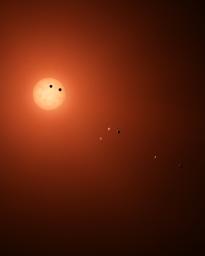
|
Transit Illustration of TRAPPIST-1
- Click the image above for a larger view
- Full-Res JPEG (3600 x 4500) (535.5 kB)
- Full-Res TIFF (3600 x 4500) (26.8 MB)
Caption:
This illustration shows the seven TRAPPIST-1 planets as they might look as viewed from Earth using a fictional, incredibly powerful telescope. The sizes and relative positions are correctly to scale: This is such a tiny planetary system that its sun, TRAPPIST-1, is not much bigger than our planet Jupiter, and all the planets are very close to the size of Earth. Their orbits all fall well within what, in our solar system, would be the orbital distance of our innermost planet, Mercury. With such small orbits, the TRAPPIST-1 planets complete a "year" in a matter of a few Earth days: 1.5 for the innermost planet, TRAPPIST-1b, and 20 for the outermost, TRAPPIST-1h.
This particular arrangement of planets with a double-transit reflect an actual configuration of the system during the 21 days of observations made by NASA's Spitzer Space Telescope in late 2016.
The system has been revealed through observations from NASA's Spitzer Space Telescope and the ground-based TRAPPIST (TRAnsiting Planets and PlanetesImals Small Telescope) telescope, as well as other ground-based observatories. The system was named for the TRAPPIST telescope.
Background Info:
NASA's Jet Propulsion Laboratory, Pasadena, California, manages the Spitzer Space Telescope mission for NASA's Science Mission Directorate, Washington. Science operations are conducted at the Spitzer Science Center at Caltech, also in Pasadena. Spacecraft operations are based at Lockheed Martin Space Systems Company, Littleton, Colorado. Data are archived at the Infrared Science Archive housed at Caltech/IPAC. Caltech manages JPL for NASA.
For more information about the Spitzer mission, visit http://www.nasa.gov/spitzer and http://spitzer.caltech.edu .
Cataloging Keywords:
| Name | Value | Additional Values |
|---|---|---|
| Target | TRAPPIST-1 | |
| System | TRAPPIST-1 | |
| Target Type | Exoplanet | |
| Mission | Spitzer Space Telescope | |
| Instrument Host | Spitzer Space Telescope | TRAPPIST |
| Host Type | Space Telescope | Ground-Based Telescope |
| Instrument | ||
| Detector | ||
| Extra Keywords | Color, Infrared, Orbit | |
| Acquisition Date | ||
| Release Date | 2017-02-22 | |
| Date in Caption | ||
| Image Credit | NASA/JPL-Caltech | |
| Source | photojournal.jpl.nasa.gov/catalog/PIA21429 | |
| Identifier | PIA21429 | |
